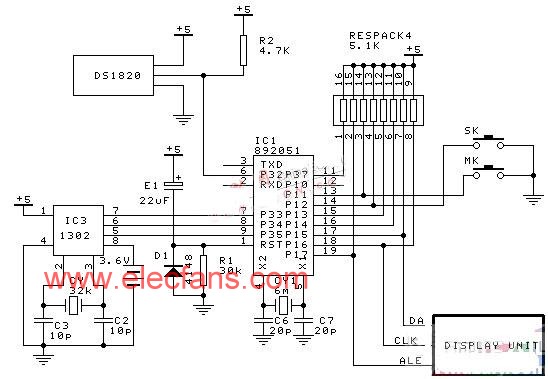This example introduces a computer electronic clock (computer perpetual calendar) made with LEDs. The photo after the decoration is finished is as follows: 
In the above picture, the year, month, day and time are selected as 1.2 inch common digital tube, the week is 2.3 inch digital tube, the temperature is 0.5 inch digital tube, or according to individual I like to use digital tubes with different specifications. The schematic is shown below: 
In the above figure, the CPU is AT89C2051, the clock chip is Dallas DS1302, the temperature sensor is Dallas digital temperature sensor DS1820, and the display driver chip is Texas Instruments TPIC6B595, which is also compatible with it. Chip NC595 or domestic AMT9595. The entire electronic clock uses two keys to adjust the time and date. One is the bit selection button and the other is the digital adjustment button. Press the bit selection button, the first two digits will start to flash and enter the setting adjustment state. At this time, press the number adjustment button, the current flashing digit can be changed.
This article refers to the address: http://
After all the parameters are adjusted, if no key is pressed within five seconds, the number stops flashing and the setting adjustment state is exited. The source program list is as follows (no temperature display program):
Start:do;
$include(reg51.dcl)
Declare (sclk,io,rst) bit at (0b3h) register; /* p33,p34,p35 */
Declare (command,data,n,temp1,num) byte;
Declare a(9) byte;
Declare ab(6) byte;
Declare aco(11) byte constant (0fdh,60h,0dah,0f2h,66h,0b6h,0beh,
0e0h, 0feh, 0f6h, 00h);
Declare week(11) byte constant (0edh,028h,0dch,7ch,39h,75h,0f5h,
2ch, 0fdh, 7dh, 00h);
Declare da literally'p15',clk literally'p16',ale literally'p17',
Mk literally'p11',sk literally'p12';
Clear:procedure;
Sclk=0; io=0; rst=0;
End clear;
Send1302:procedure(comm);
Declare (i,comm) byte;
Do i=0 to 7;
Comm=scr(comm,1);
Io=cy;
Call time(1);
Sclk=0;
Call time(1);
Sclk=1;
End;
End send1302;
Wbyt1:procedure(com,dat);/*byte write process*/
Declare (com,dat) byte;
Call clear;
Rst=1;
Call send1302(com);
Call send1302(dat);
Call clear;
End wbyt1;
Wbyt8:procedure;/*clock multibyte burst mode write process*/
Declare j byte;
Call clear;
a(7)=A(6); a(6)=a(0);
Rst=1;
Call send1302(command);
Do j=1 to 8;
Call send1302(a(j));
End;
Call clear;
End wbyt8;
RBYT1: PROCEDURE;
DECLARE I BYTE;
CALL CLEAR;
RST=1;
Call send1302(0c1h);
IO=1;
DO I=0 TO 7;
SCLK=1;
SCLK=0;
CY=IO;
N=SCR(N,1);
END;
A(8)=N;
CALL CLEAR;
END RBYT1;
Send595:procedure;
Declare k byte;
Do k=0 to 7;
Data=scr(data,1);
Da=cy;
Clk=1;
Clk=0;
End;
End send595;
Send595_1:procedure;
Declare k byte;
Do k=0 to 7;
Data=scr(data,1);
Da1=cy;
Clk1=1;
Clk1=0;
End;
End send595_1;
Rb1:procedure(abc,j);
DECLARE (I, j, abc) BYTE;
CALL CLEAR;
RST=1;
Call send1302(abc);
IO=1;
DO I=0 TO 7;
SCLK=1;
SCLK=0;
CY=IO;
N=SCR(N,1);
END;
Ab(j)=N;
Ab(j)=dec(ab(j));
CALL CLEAR;
End rb1;
Rbyt6:procedure;
Call rb1(0f1h,0);
Call rb1(0f3h,1);
Call rb1(0f5h,2);
Call rb1(0f7h,3);
Call rb1(0f9h,4);
Call rb1(0fbh,5);
Call rb1(0fdh,6);
End rbyt6;
Wbyt6:procedure;
Call wbyt1(8eh,0); /* write enable */
Call wbyt1(0f0h,ab(0));
Call wbyt1(0f2h,ab(1));
Call wbyt1(0f4h,ab(2));
Call wbyt1(0f6h,ab(3));
Call wbyt1(0f8h,ab(4));
Call wbyt1(0fah,ab(5));
Call wbyt1(0fch,ab(6));
Call wbyt1(8eh,80h); /* write disable */
End wbyt6;
Rbyt8:procedure;/*clock multibyte burst mode read process*/
Declare (i,j) byte;
Call clear;
Rst=1;
Call send1302(command);
Io=1;
Do j=1 to 8;
Do i=0 to 7;
Sclk=1;
Call time(1);
Sclk=0;
Cy=io;
n=scr(n,1);
End;
a(j)=n;
End;
Call clear;
a(0)=a(6); a(6)=A(7);
a(0)=a(0) and 0fh;
If a(0)>6 then a(0)=0;
CALL RBYT1;
If (a(1)=0 and a(2)=0 and a(3)=0) then
Do;
Do num=0 to 35;
Call time(250);
End;
Temp1=1;
End;
If temp1=1 then
Do;
Temp1=0;
Ab(4)=ab(4)+1;
If ab(4)>99h then
Do;
Ab(4)=0;
Ab(5)=ab(5)+1;
If ab(5)>99h then ab(5)=0;
End;
Call wbyt6;
End;
End rbyt8;
Display:procedure; /*jieya,yima,fasong*/
Declare (i,n,m) byte;
n=a(0) and 0fh; /* send week */
Data=week(n);
Call send595;
n=a(4); /* send date */
n=n and 0fh;
Data=aco(n);
Call send595;
n=a(4);
n=shr(n,4);
Data=aco(n);
Call send595;
Do i=1 to 3; /* send second,minute,hour */
n=a(i);
n=n and 0fh;
Data=aco(n);
Call send595;
n=a(i);
n=shr(n,4);
Data=aco(n);
Call send595;
End;
Do i=5 to 6; /* send month,year */
n=a(i);
n=n and 0fh;
Data=aco(n);
Call send595;
n=a(i);
n=shr(n,4);
Data=aco(n);
Call send595;
End;
n=a(8); /* send 19 or 20 */
n=n and 0fh;
Data=aco(n);
Call send595;
n=a(8);
n=shr(n,4);
Data=aco(n);
Call send595;
Do m=0 to 5;
n=ab(m);
n=n and 0fh;
Data=aco(n);
Call send595_1;
n=ab(m);
n=shr(n,4);
Data=aco(n);
Call send595_1;
End;
Ale=0;
Ale=1;
End display;
Beginset:procedure;
a(0)=06h; a(1)=58h; a(2)=59h; a(3)=23h;
a(4)=30h; a(5)=06h; a(6)=97h; a(7)=00;
a(8)=19h; /* set date/time (1997,7,1,8:00:00,week 3) */
Call wbyt1(8eh,0); /* write enable*/
Call wbyt1(80h,00h);/* start colock */
Call wbyt1(0beh,0abh);/*Two diodes are connected in series with 8K resistors*/
Command=0beh; /* write colock/date */
Call wbyt8;
Call wbyt1(0c0h,a(8));
Call wbyt1(8eh,80h); /* set write protect bit */
End beginset;
Key:procedure;
Declare (i, time1, k1, tem) byte;
Call time(100);
K1=7; time1=30;
If mk=0 then
Do;
Do while time1>0;
Week: if k1=0 then
Do;
Do i=0 to 5;
/* call hz(a(0)); */
End;
Do i=0 to 3;
/* call hz0; */
End;
End;
Tem=a(k1);
If k1=7 then tem=a(8);
a(k1)=0aah;
If k1=7 then a(8)=0aah;
Call display;
Call time(254);
Call time (254);
a(k1)=tem;
If k1=7 then a(8)=tem;
Call display;
Call time(254);
Call time(254);
Call time(254);
Time1=time1-1;
If mk=0 then
Do;call time(100); /*MOD KEY PROCESS*/
TIME1=30;
IF MK=0 THEN
DO;
K1=k1-1;
DO WHILE K1=0FFH;
K1=7;
END;
END;
End;
IF SK=0 THEN
DO;CALL TIME(100); /*SET KEY PROCESS*/
TIME1=30;
IF SK=0 THEN
DO;
Tem=tem+1;
Tem=dec(tem);
DO CASE K1;
DO WHILE tem=7;/*week*/
Tem=0;
END;
DO WHILE tem=60H;/*scond*/
Tem=0;
END;
DO WHILE tem=60H;/*minute*/
Tem=0;
END;
DO WHILE tem=24H;/*hour*/
Tem=0;
END;
DO WHILE tem=32H;/*date*/
Tem=1;
END;
DO WHILE tem=13H;/*month*/
Tem=1;
END;
DO while tem=100h; /* YEAR */
Tem=00;
END;
DO WHILE TEM>=21H;
Tem=19H;
END;
END;
A(K1)=tem;
If k1=7 then a(8)=tem;
END;
END;
END;
END;
End key;
Main$program:
Mk=1; sk=1; temp1=0; num=0; p32=1;
If sk=0 then call beginset;
Clk=0;da=0;ale=1;
Loop:
Do while mk=1 ;
If a(0)>6 then a(0)=0;
Command=0bfh;
Call rbyt8;
Call display;
Do while mk=0;
Call key;
Call wbyt1(8eh,0);
Command=0beh;
Call wbyt8;
Call wbyt1(0C0H,A(8));
Call wbyt1(8eh,80h);
End;
End;
Goto loop;
End start
High brightness, the light source is made of imported ultra-high brightness LED series, 120LED / m or 144LED / m encryption arrangement is the fundamental guarantee of the overall luminous effect and high brightness.
DIP & SMD LED lamps are options for different application.
Neon Letters,Led Alphabet Letters,Led Light Up Letters,Custom Led Letters
Shenzhen Oleda Technology Co.,Ltd , https://www.baiyangsign.com